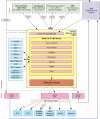Semantic tagging of and semantic enhancements to systematics papers: ZooKeys working examples
- PMID: 21594113
- PMCID: PMC3088020
- DOI: 10.3897/zookeys.50.538
Semantic tagging of and semantic enhancements to systematics papers: ZooKeys working examples
Abstract
The concept of semantic tagging and its potential for semantic enhancements to taxonomic papers is outlined and illustrated by four exemplar papers published in the present issue of ZooKeys. The four papers were created in different ways: (i) written in Microsoft Word and submitted as non-tagged manuscript (doi: 10.3897/zookeys.50.504); (ii) generated from Scratchpads and submitted as XML-tagged manuscripts (doi: 10.3897/zookeys.50.505 and doi: 10.3897/zookeys.50.506); (iii) generated from an author's database (doi: 10.3897/zookeys.50.485) and submitted as XML-tagged manuscript. XML tagging and semantic enhancements were implemented during the editorial process of ZooKeys using the Pensoft Mark Up Tool (PMT), specially designed for this purpose. The XML schema used was TaxPub, an extension to the Document Type Definitions (DTD) of the US National Library of Medicine Journal Archiving and Interchange Tag Suite (NLM). The following innovative methods of tagging, layout, publishing and disseminating the content were tested and implemented within the ZooKeys editorial workflow: (1) highly automated, fine-grained XML tagging based on TaxPub; (2) final XML output of the paper validated against the NLM DTD for archiving in PubMedCentral; (3) bibliographic metadata embedded in the PDF through XMP (Extensible Metadata Platform); (4) PDF uploaded after publication to the Biodiversity Heritage Library (BHL); (5) taxon treatments supplied through XML to Plazi; (6) semantically enhanced HTML version of the paper encompassing numerous internal and external links and linkouts, such as: (i) vizualisation of main tag elements within the text (e.g., taxon names, taxon treatments, localities, etc.); (ii) internal cross-linking between paper sections, citations, references, tables, and figures; (iii) mapping of localities listed in the whole paper or within separate taxon treatments; (v) taxon names autotagged, dynamically mapped and linked through the Pensoft Taxon Profile (PTP) to large international database services and indexers such as Global Biodiversity Information Facility (GBIF), National Center for Biotechnology Information (NCBI), Barcode of Life (BOLD), Encyclopedia of Life (EOL), ZooBank, Wikipedia, Wikispecies, Wikimedia, and others; (vi) GenBank accession numbers autotagged and linked to NCBI; (vii) external links of taxon names to references in PubMed, Google Scholar, Biodiversity Heritage Library and other sources. With the launching of the working example, ZooKeys becomes the first taxonomic journal to provide a complete XML-based editorial, publication and dissemination workflow implemented as a routine and cost-efficient practice. It is anticipated that XML-based workflow will also soon be implemented in botany through PhytoKeys, a forthcoming partner journal of ZooKeys. The semantic markup and enhancements are expected to greatly extend and accelerate the way taxonomic information is published, disseminated and used.
Keywords: Semantic tagging; semantic enhancements; systematics; taxonomy.
Figures




References
-
- Agosti D, Klingenberg C, Sautter G, Johnson N, Stephenson C, Catapano T.(2007) Why not let the computer save you time by reading the taxonomic papers for you? Biológico, São Paulo 69 (suplemento 2): 545-548.
LinkOut - more resources
Full Text Sources
